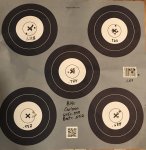Join the Hide community
Get access to live stream, lessons, the post exchange, and chat with other snipers.
Register
Download Gravity Ballistics
Get help to accurately calculate and scope your sniper rifle using real shooting data.

Install the app
How to install the app on iOS
Follow along with the video below to see how to install our site as a web app on your home screen.
Note: This feature may not be available in some browsers.
You are using an out of date browser. It may not display this or other websites correctly.
You should upgrade or use an alternative browser.
You should upgrade or use an alternative browser.
6X5 Thread V5.0 *new 1/1/21*
- Thread starter jbell
- Start date
Here is my 6X5, SK Match (red box) shot at 50 yards with my Vudoo Ridgeback 18" Proof barrel, Bushnell Forge 4.5x27 using my bipod and bag. There was not much wind. I measured using the Sub Moa app not sure if that correct, if you want me to so something else let me know. I imputed .224" as the bullet dia.
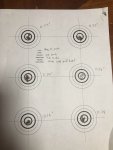
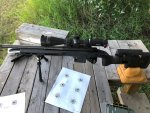


updated groups
on my 3rd range trip with this gun continues to get better
winds 5-7mph
bergara b14r -steel
norma match 22lr
measured outside to outside and subtracted .190
6 x 5 avg .368
best .247
notice the big poi shift on my 4th group, that is because on the 1st shot either i pulled it or the ammo did and i was not going to let that bad shot ruin my groups so i just aimed for that hole on the next 4 and it worked out


on my 3rd range trip with this gun continues to get better
winds 5-7mph
bergara b14r -steel
norma match 22lr
measured outside to outside and subtracted .190
6 x 5 avg .368
best .247
notice the big poi shift on my 4th group, that is because on the 1st shot either i pulled it or the ammo did and i was not going to let that bad shot ruin my groups so i just aimed for that hole on the next 4 and it worked out
Guys I'm a br shooter and this is not how you measure groups. You measure the farthest points in the group and subtract .224 cause that's the size of a scoring plug not the size of a bullet hole lmao. Dont know who taught yall how to do this but it is not correct.Welcome dieselboy_01, I have you on the results.
tsgarp I have your average updated.
Guys I'm a br shooter and this is not how you measure groups. You measure the farthest points in the group and subtract .224 cause that's the size of a scoring plug not the size of a bullet hole lmao. Dont know who taught yall how to do this but it is not correct.
I really don't mean to be argumentative but if the bullet is making a hole in the paper smaller than what your subtracting to get your CTC size after measuring outer edge to outer edge then your CTC group size will be smaller than it really is.
I haven't seen any target material that a 22lr will make a 0.224" diameter hole in. Most all I have measured will be right around 0.220" (some as small as 0.218") from the edge of the black ring to the furthest most opposite edge of the black ring. That is why I measure and advocate measuring so there is the slightest amount of target showing between the blade of your caliper and the black ring about 0.001"-0.002" that way you can know your consistent from group to group and then subtract 0.222". If you try and measure right to the edge of the black ring you will be more likely to measure small by covering some of the ring with the blade of your caliper.
I can see subtracting 0.224" if your opening the hole up with a scoring plug but if your shooting for groups why would you ever stick a scoring plug in the hole? I use them when shooting for score in both air rifle and rimfire if I'm not shooting on an electric scoring range.
I'm not a benchrest shooter nor do I have any interest in it, so I don't have any experience in measuring for the discipline. So I may be completely incorrect but all the rimfire benchrest matches I have seen are shooting for score, not groups hence the scoring plug.
It seems to me like your comparing apples to oranges...
@jbell:I really don't mean to be argumentative but if the bullet is making a hole in the paper smaller than what your subtracting to get your CTC size after measuring outer edge to outer edge then your CTC group size will be smaller than it really is.
I haven't seen any target material that a 22lr will make a 0.224" diameter hole in. Most all I have measured will be right around 0.220" (some as small as 0.218") from the edge of the black ring to the furthest most opposite edge of the black ring. That is why I measure and advocate measuring so there is the slightest amount of target showing between the blade of your caliper and the black ring about 0.001"-0.002" that way you can know your consistent from group to group and then subtract 0.222". If you try and measure right to the edge of the black ring you will be more likely to measure small by covering some of the ring with the blade of your caliper.
I can see subtracting 0.224" if your opening the hole up with a scoring plug but if your shooting for groups why would you ever stick a scoring plug in the hole? I use them when shooting for score in both air rifle and rimfire if I'm not shooting on an electric scoring range.
I'm not a benchrest shooter nor do I have any interest in it, so I don't have any experience in measuring for the discipline. So I may be completely incorrect but all the rimfire benchrest matches I have seen are shooting for score, not groups hence the scoring plug.
It seems to me like your comparing apples to oranges...
Is the number to subtract a calibration issue? Shoot 5 shots to make five individual holes. Measure each using your method of leaving a slight amount of target showing and use the average as the subtraction number. You probably thought of this long time passing and for reasons I do not realize have discarded it. However, would seem to normalize differences in target material and caliper usage.
My problem with all this is, the holes vary, depending on type of paper/target. I have some holes measuring .17, some .220, some .117.. While I understand the logic @jbell is stating, it doesnt allow for comparable groups or a standard to follow. This is why I personally believe the method everyone I know follows is just subtracting bullet diameter.
If we know every single person here measured outside to outside and subtracted .223, we know the results are 100% comparable... But if one guys subtracts, .223, one guy subtracts .224, one guy subtracts .117, one guy subtracts .171, one guy subtracts .210, etc...... None of this is comparable if you ask me. There is no standard. I think thats why subtracting bullet diameter has always been the method, because its a standard to which everyone can follow and accurately compare results. Not because its the scientific way to find an exact measurement. I personally have never heard of this measure your holes 5x and find averages and then use that to subtract and then do the same on the next group and so on and so forth.
But that's just my $0.02
If we know every single person here measured outside to outside and subtracted .223, we know the results are 100% comparable... But if one guys subtracts, .223, one guy subtracts .224, one guy subtracts .117, one guy subtracts .171, one guy subtracts .210, etc...... None of this is comparable if you ask me. There is no standard. I think thats why subtracting bullet diameter has always been the method, because its a standard to which everyone can follow and accurately compare results. Not because its the scientific way to find an exact measurement. I personally have never heard of this measure your holes 5x and find averages and then use that to subtract and then do the same on the next group and so on and so forth.
But that's just my $0.02
My problem with all this is, the holes vary, depending on type of paper/target. I have some holes measuring .17, some .220, some .117.. While I understand the logic @jbell is stating, it doesnt allow for comparable groups or a standard to follow. This is why I personally believe the method everyone I know follows is just subtracting bullet diameter.
If we know every single person here measured outside to outside and subtracted .223, we know the results are 100% comparable... But if one guys subtracts, .223, one guy subtracts .224, one guy subtracts .117, one guy subtracts .171, one guy subtracts .210, etc...... None of this is comparable if you ask me. There is no standard. I think thats why subtracting bullet diameter has always been the method, because its a standard to which everyone can follow and accurately compare results. Not because its the scientific way to find an exact measurement. I personally have never heard of this measure your holes 5x and find averages and then use that to subtract and then do the same on the next group and so on and so forth.
But that's just my $0.02
People are already pulling calipers out, why not just measure the hole the round is leaving in that paper/target and using it for the subtraction?
If everyone always subtracted the same thing, but they all shot on different paper types, then it's not really comparable?
People are already pulling calipers out, why not just measure the hole the round is leaving in that paper/target and using it for the subtraction?
If everyone always subtracted the same thing, but they all shot on different paper types, then it's not really comparable?
Because the holes aren't consistent. That's why. I did this in another thread...i can measure 3 holes on the same target and get 3 completely different measurements...one where there is solid wood behind that hole, one where there is partial cardboard, one where there is nothing, a shot out hole in the wood behind the paper.....Do you take the largest hole or the smallest hole no? no consistency. That's why all these years on the Hide, everyone has been subtracting bullet diameter....
The problem here also is, 1000's submitting results and scoring themselves. Its for fun...
If this was a match, we would have 1 person scoring those targets 1 way. However the way they measured, it would be consistent across all the targets. I think we need to keep this in mind.
If this was a match, we would have 1 person scoring those targets 1 way. However the way they measured, it would be consistent across all the targets. I think we need to keep this in mind.
I subtract bullet hole dia I measure on the target because if I subtracted 224 then use that measurement center to center on my calipers I can clearly see it is not the true center to center
And I am not going to lie to myself that I shot a better group then I did
So the bullet that passed through the target doesnt measure what it measures??? Is that what youre saying? Regardless how the target/paper/etc reacts, that bullet actually measures what it measures. It doesnt magically shrink to .17, or .2 or .220 or .21 in the air on the way to the target... Your lying to yourself one way or the other..Either on the CTC or the bullet diameter....
And to be clear, I dont care how you guys measure. Its all in good fun. Im just stoking a conversation and thought process on this topic. And trying to highlight why guys have always measured bullet diameter. If you feel your lying to yourself doing that, for whatever reason, then measure it how you want. Its for your fun and satisfaction, there are no prizes, awards, trophy's, etc being given here.
First, thank you @padom for stating it is both the hole and the backing that is important. I had forgotten about the backing.
If you measure 5 holes on same target/backing with same ammunition and have the variation you describe it tells me that the precision of your group has an uncertainty of at least the standard deviation of the sizes of the bullet holes. And that uncertainty limits the ability to know if two 6 x 5 averages or best groups are truly different. That's my $0.02 worth.
For me the discussion is a poor substitute for not being able to go to the range.
If you measure 5 holes on same target/backing with same ammunition and have the variation you describe it tells me that the precision of your group has an uncertainty of at least the standard deviation of the sizes of the bullet holes. And that uncertainty limits the ability to know if two 6 x 5 averages or best groups are truly different. That's my $0.02 worth.
For me the discussion is a poor substitute for not being able to go to the range.
I agree with you guys in that everyone is going to measure differently. I also agree that this is JUST for fun, so it really doesn't matter at all. I really don't care how anyone measures their targets for this thread. Back in the first go round of the rimfire 6X5 the people who were regularly contributing we all talked this through and after the end of it all we decided to not use bullet diameter 0.224" because none of us had ever measured a single bullet hole that was 0.224" they were all under with the largest being 0.222" which is why we settled on 0.222".
Please don't get me wrong guys I truly don't care how you do it, this is merely for conversation. I do not view this as "my thread", it is all of ours. I love shooting and especially rimfire shooting. I really don't have time to maintain this thread at times, but I really enjoy seeing everyone's targets, and rifles, and the conversations we have.
Please don't get me wrong guys I truly don't care how you do it, this is merely for conversation. I do not view this as "my thread", it is all of ours. I love shooting and especially rimfire shooting. I really don't have time to maintain this thread at times, but I really enjoy seeing everyone's targets, and rifles, and the conversations we have.
So the bullet that passed through the target doesnt measure what it measures??? Is that what youre saying? Regardless how the target/paper/etc reacts, that bullet actually measures what it measures. It doesnt magically shrink to .17, or .2 or .220 or .21 in the air on the way to the target... Your lying to yourself one way or the other..Either on the CTC or the bullet diameter....
And to be clear, I dont care how you guys measure. Its all in good fun. Im just stoking a conversation and thought process on this topic. And trying to highlight why guys have always measured bullet diameter. If you feel your lying to yourself doing that, for whatever reason, then measure it how you want. Its for your fun and satisfaction, there are no prizes, awards, trophy's, etc being given here.
what i am trying to get across is
if i measure several single bullet holes and the average out to .200
then i measure my group outside to outside edge with my calipers and then subtract .224 on them
then hold them on my group i can clearly see that is not the true center to center
if that makes sense, if i went with the smaller group size it would bother me know it was wrong
again the measuring thing is what i do
this is all for fun and i enjoy seeing the targets what others have been able to shoot with certain guns and the skills they have - it is very impressive how small the groups 22lr are capable of
My first go at a 100 yard 6 x 5. This should put me at or near the bottom of the table, but hopefully it should be the basis for improvement.
Tikka T1x, 16 inch, suppressed. Crosswind from zero to about 5mph.
Smallest 0.796"
Largest 1.825"
Average 1.397"


Tikka T1x, 16 inch, suppressed. Crosswind from zero to about 5mph.
Smallest 0.796"
Largest 1.825"
Average 1.397"


Because the holes aren't consistent. That's why. I did this in another thread...i can measure 3 holes on the same target and get 3 completely different measurements...one where there is solid wood behind that hole, one where there is partial cardboard, one where there is nothing, a shot out hole in the wood behind the paper.....Do you take the largest hole or the smallest hole no? no consistency. That's why all these years on the Hide, everyone has been subtracting bullet diameter....
I believe, this is why, the standard I always understood was using .220”.
That is what was factored as well back in the early days of 22 BR group shooting, mostly NBRSA which seems to have died a quiet death.
Where .224” came in was likely the early plugs which are now smaller in sanctioning bodies.
I don’t know of any 22lr slug that leaves a barrel, especially a custom barrel @.224”
I believe, this is why, the standard I always understood was using .220”.
That is what was factored as well back in the early days of 22 BR group shooting, mostly NBRSA which seems to have died a quiet death.
Where .224” came in was likely the early plugs which are now smaller in sanctioning bodies.
I wouldnt disagree with this...a standard number that everyone subtracts, whatever that numbers is, makes things consistent and comparable. That's all im saying
I wouldnt disagree with this...a standard number that everyone subtracts, whatever that numbers is, makes things consistent and comparable. That's all im saying
You want to do threads like this a great service, get somebody to give some kind of a “ basics of measuring groups” type sticky.
I am still trying to wrap my head around the shear magnitude of internet groups where guys convince themselves that two holes side my side, or literally with paper between them, measure in the .100’s ?
I wouldnt disagree with this...a standard number that everyone subtracts, whatever that numbers is, makes things consistent and comparable. That's all im saying
You want to do threads like this a great service, get somebody to give some kind of a “ basics of measuring groups” type sticky.
I am still trying to wrap my head around the shear magnitude of internet groups where guys convince themselves that two holes side my side, or literally with paper between them, measure in the .100’s ?
I agree with you guy, we tried to implement it back many years ago but it just seemd to not take. If y’all want I can try again with the next iteration of the 6X5 (probably next year 01/01/21). What does everyone think? If y’all want to do this what do you guys think the standard should be??
I will start another thread so we can discuss this there and keep the chatter to a minimum here on this one to not deter people who simply want to view the 6X5.
jbell, I would like to see a draft of the measurement "instructions" so we all can comment on the language. The real challenge to me is when you have a group which ends up essentially a ragged hole, or an oversized single hole where 5 shots went through the target. With no bullet holes to speak of, how the heck do you accurately measure that? Maybe folks can send in examples (pictures) where the measurement was very challenging? I also suggest the instructions should also include a picture as examples of how to measure the various hole configurations, especially the challenging ones so folks can consistently measure as described.I agree with you guy, we tried to implement it back many years ago but it just seemd to not take. If y’all want I can try again with the next iteration of the 6X5 (probably next year 01/01/21). What does everyone think? If y’all want to do this what do you guys think the standard should be??
I will start another thread so we can discuss this there and keep the chatter to a minimum here on this one to not deter people who simply want to view the 6X5.
Just a thought...
jbell, I would like to see a draft of the measurement "instructions" so we all can comment on the language. The real challenge to me is when you have a group which ends up essentially a ragged hole, or an oversized single hole where 5 shots went through the target. With no bullet holes to speak of, how the heck do you accurately measure that? Maybe folks can send in examples (pictures) where the measurement was very challenging? I also suggest the instructions should also include a picture as examples of how to measure the various hole configurations, especially the challenging ones so folks can consistently measure as described.
Just a thought...
Ok, I'll see what I can come up with as an example. I'll put it in the other thread I created this morning.
jbell, here are two I made up this morning. A work in progress, but a picture is likely better than 1000 words...
I posted the pictures in the new thread as well, with a few discussion points, and additional pictures showing different measurement techniques.
FYI.
I posted the pictures in the new thread as well, with a few discussion points, and additional pictures showing different measurement techniques.
FYI.
Attachments
Last edited:
Second attempt at the 6x5 at 50 yards with my 1712 and used Center-X this time. I only ordered one box of 50, so I may have to get a brick coming because I am than one thing holding back this set-up.... NOTE: CTC was calculated by subtracting .220; let me know if I should be using a different figure.




Last edited:
AVG 0.61MOA
Smallest group 0.49”
Vudoo V22 18” Proof Barrel
Shot off Ckye pod and tab str8 laced bag sitting at a bench indoors @ 100yds.
Got some more to add to the list. Had some good conditions so ran to the range to test ammo in a new gun and get a 50 yard target for the B14 steel.
CZ457 PV with Vortex DB Tac 4-16 And Spectre 2
Bench-bipod-bag
SK+
1-3 mph
51 Yards 6x5=.365 with a best of .226 And 101 yards 6x5=1.108 with a best of .621

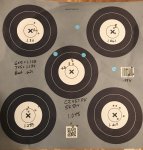
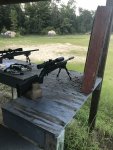
Went ahead and shot a close target for the B14 Steel. 51 yards best 6x5=.367 with a best of .210 on one of the targets in the other 6x5

CZ457 PV with Vortex DB Tac 4-16 And Spectre 2
Bench-bipod-bag
SK+
1-3 mph
51 Yards 6x5=.365 with a best of .226 And 101 yards 6x5=1.108 with a best of .621



Went ahead and shot a close target for the B14 Steel. 51 yards best 6x5=.367 with a best of .210 on one of the targets in the other 6x5

Last edited:
Melglass, that is pretty consistent shooting between your Bargara and CZ. I have them updated.
I think I’m at the end of my current ability with bipod and bag. My mistakes show up at 50 but really kill me past that. End up with a shot or two in every 6x5 that keeps me from a very good average.Melglass, that is pretty consistent shooting between your Bargara and CZ. I have them updated.
Hello everyone. This is my first go at the 6x5 at 200 yards. Nice day 68 deg with light wind. Shooting Lapua Center
Tikka T1x
Trigger at 2.5lbs
Harris bipod
Tikka vert grip
T3x butt pad
Victor cheek rest
Area419 30moa rail
Seekins 30mm .97 high rings
Vortex level
Sightron S3 6-24x50
shot off the bench with rear bag ( sore back so no prone today )
Group
1 3.45
2 3.92
3 .46
4 1.70
5 2.55
6 2.04
best group was .46 ( true unicorn group )
average is 2.41
my wife also shot this 6x5 and did very well. I’ll see if I can get her to register so she can participate in this as well


Tikka T1x
Trigger at 2.5lbs
Harris bipod
Tikka vert grip
T3x butt pad
Victor cheek rest
Area419 30moa rail
Seekins 30mm .97 high rings
Vortex level
Sightron S3 6-24x50
shot off the bench with rear bag ( sore back so no prone today )
Group
1 3.45
2 3.92
3 .46
4 1.70
5 2.55
6 2.04
best group was .46 ( true unicorn group )
average is 2.41
my wife also shot this 6x5 and did very well. I’ll see if I can get her to register so she can participate in this as well
Last edited:
Hi folks. Got a chance to get out again today with another lot of CenterX to see how I could do with it at 200. I wasn’t able to beat yesterday’s best group ( probably never will ) but did manage to beat my average from yesterday. So far the 2 lots of Lapua CenterX thT I have seem to be shooting the same for me.
groups from today
1. 1.42
2. 2.18
3. 2.95
4. 2.38
5. 1.83
6. 2.17
best from today 1.42
Average from today. 2.15
im really digging this way to test lots and test myself.

groups from today
1. 1.42
2. 2.18
3. 2.95
4. 2.38
5. 1.83
6. 2.17
best from today 1.42
Average from today. 2.15
im really digging this way to test lots and test myself.
Last edited:
545riflefan, that is some very fine shooting! Well done. I have you on the results. I look forward to more from you and your Tikka.
jbell, good day to you. I had a chance to shoot at 100 yards this morning. Winds were calm, temp 77, RH 84%. 6 targets attached, 0.719, 0.513, 0.414, 0.668, 0.521, 0.668 = 3.503/6 = 0.583 CTC average. This improves on my prior attempt for overall group size, but not for best individual group size. Shooting the same rifle, Anschutz 1903 SBR, Athlon 10x40 scope, using a rest for benchrest shooting (no bipod and bag). Let me know if you need anything further? Thanks for all you do to maintain this thread!
Attachments
yesterday i went out for the second time with my new ruger 10/22 comp custom shop and it went head to head with my ruger american rimfire target
the 10/22 won by a mile but i still love the ruger bolt gun but it always has fliers
50 yard results
10/22 avg .343 with a best of .260
rart avg .533 with a best of .390
the 10/22 won by a mile but i still love the ruger bolt gun but it always has fliers
50 yard results
10/22 avg .343 with a best of .260
rart avg .533 with a best of .390
Attachments
New here (new to ANY forum), and thought this looked like fun. 50 yard 6x5 using CZ 457 Varmint Precision Chassis, Diamondback Tactical, SK Yellow Box, Bipod and rear bag. Average .274", best .189". 
Welcome To the 6X5!New here (new to ANY forum), and thought this looked like fun. 50 yard 6x5 using CZ 457 Varmint Precision Chassis, Diamondback Tactical, SK Yellow Box, Bipod and rear bag. Average .274", best .189".
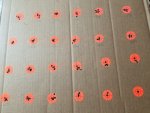
Was testing some ammo and thought I'd give this a go.
Second row was shot with:
Vudoo 22 w/18"Ace in MPA
CenterX
From wooden bench with Atlas Cal and rear bag
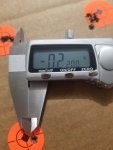
I used .220 to zero before I read to use .222 so left to right is.
.219, .220, .194, .504, .259, .204 for .266avg
.264avg if .222 is used to zero.
Thanks
Similar threads
- Replies
- 0
- Views
- 203
- Replies
- 21
- Views
- 2K
- Replies
- 1
- Views
- 277
- Replies
- 0
- Views
- 191
- Replies
- 0
- Views
- 220



